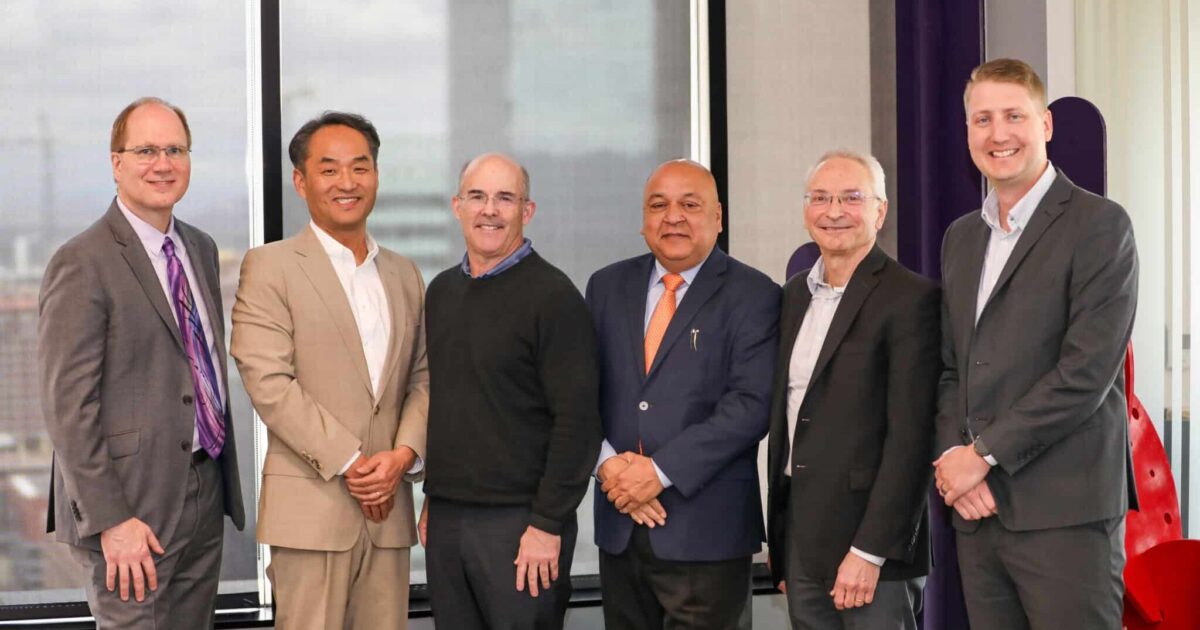

Ambassador Event: The Next Era of Semicon
Published: 04/09/2024
Updated: 04/10/2024
GPEC convenes industry leaders to discuss the ecosystem’s progress and future
Greater Phoenix plays a pivotal role in advancing the semiconductor industry in the United States and internationally. With more than 155 semiconductor-related companies operating in the region, including industry giants Intel and TSMC, Greater Phoenix has emerged as the heart of advanced manufacturing innovation.
On March 26, GPEC hosted the Next Era of Semicon Ambassador Event in which industry experts from Amkor Technology, Inc., ASM, ASML, Arizona State University (ASU) Knowledge Enterprise and EMD Electronics discussed growth in the ecosystem, the attractiveness of Arizona and Greater Phoenix, and the importance of education, government support, and innovation.
The panel consisted of:
• David Kim, Vice Chair, U.S. Management Team/Head of Legal and Compliance, U.S., ASML
• David McCann, Senior VP, Chief of Staff, Business Unit, Amkor Technology
• Kevin Reinhart, Executive Director, Emerging Research Technology, ASU Knowledge Enterprise
• Arthur Sherman, VP, Marketing, ASM International N.V.
• Dr. Saifi Usmani, Vice President/Head of Planarization, EMD Electronics, the electronics business of Merck KGaA, Darmstadt, Germany
• Thomas Maynard (Moderator), Senior Vice President, Business Development, GPEC
Recent Developments in Semiconductors and the CHIPS Act
As Arizona leads efforts to reshore and onshore semiconductor manufacturing, Maynard highlighted TSMC’s fab construction milestones and Intel’s total investment of $66B, with the most recent $8.5 billion CHIPS Act investment announced when President Biden visited Greater Phoenix earlier in March, emphasizing Arizona’s significance in the sector.
Although the U.S. reshoring of semiconductor manufacturing is still in its early stages, geopolitical factors and the CHIPS Act are enabling swift progress. Usmani referred to the semiconductor ecosystem momentum and enablers in places like Taiwan and Korea. “CHIPS Act was needed because the threshold to bring business here was much higher,” Usmani said. “We needed that investment to enable that.”
“The CHIPS Act isn’t the only thing that was driving this re-shoring movement… I would say geopolitics had a lot to do with it,” added Kim. “I think there’s a national security interest as well as a political dimension to having the necessary capabilities that are so critical to economic well-being.”
Another dimension of U.S. semiconductor growth is centralizing the supply chain to maximize economic potential and national security. “From a security checkpoint … the whole supply chain needs to be brought in,” McCann said. “Success breeds success. So, if the fabs are successful, we’re successful, we’ll bring supply chains here … there’ll be more factories who supply all of us and then our competitors will come here.”
As part of this expansion driven by the CHIPS Act and in collaboration with partners, Arizona State University (ASU) recently revised its semiconductor strategy, focusing on a “lab-to-fab” translational space model. “We recognize that faculty research is the start of that pipeline,” Reinhart said.
Another key pillar in ASU’s strategy is core facilities, where large-scale tenants can place, test and develop their custom semiconductor processing tools. An example is the Materials-to-Fab Center, a cutting-edge research, development and prototyping facility established in partnership with Applied Materials and the Arizona Commerce Authority to accelerate research, innovation and opportunities for hands-on learning.
“They’re investing in sponsored research, they’re funding the students,” said Reinhart. “That’s not just research for the sake of research, but research that is meaningful to the industry. Student researchers are engaged in those kinds of research projects, and they get their hands on that experiential learning that helps them when they’re going into the industry.”
Another notable achievement has been the ASU-led Southwest Advanced Prototyping Hub which was granted $40M in CHIPS Act funding as one of eight Microelectronics Commons Hubs awarded to further accelerate manufacturing of next generation materials for quantum mechanics and artificial intelligence (AI). As the U.S. Department of Defense is expected to propose topics and calls for projects, ASU Knowledge Enterprise encourage actions “to engage with the ecosystem at ASU or engage with the faculty, the researchers, with the industry…to bring that innovation to the Valley,” Reinhart said.
Collaboration between educational institutes and companies like Amkor, ASM, ASML and EMD Electronics contribute to outsourced assembly and equipment testing, atomic layer deposition technology, and planarization materials which highlight their significant roles in advancing the semiconductor industry's capabilities.
Learn more on Greater Phoenix specific developments on the CHIPS Act
Building the Industry’s Workforce
The importance of local talent availability and collaborative workforce initiatives underscored the breadth of economic development in conversations. The panelists stressed that while Arizona and Greater Phoenix continue to advance as world-class locations for business and living, it is important to address workforce development by making it easier to find and connect with talent.
Apprenticeships and trade programs play a significant role in supporting the talent pipeline, which panelists said was evenly distributed between higher education degree holders from around the U.S and world and those who attended vocational programs. Companies find advantages working with both groups of employees and the schools that train them, implementing job-specific requirements into college curriculum and inspiring student interest. One recent example was how Western Maricopa Education Center (West-MEC) partnered with Amkor Technology to connect them with high-school students and present job specifics and benefits, shared McCann.
“(A) critical mass of companies in and of itself drives the ability to have people come into the region and feel like (it) not only is a good place to work, but it’s a good place where if, for whatever reason (their) career changes, (they're) not going to move somewhere else”, Sherman said. “(Greater Phoenix) is becoming, because of the density of new opportunities, the kind of place where there’s much less risk, and that does help us in terms of recruiting from all over the world”.
Usmani said semiconductor companies continue to choose the region because the customer base and talent availability coexists in Greater Phoenix.
Among competitor states such as New Mexico, California, New York and Ohio, Arizona has a supportive regulatory environment and welcoming economic climate, said Sherman, adding “the outlook is very good for Greater Phoenix as a region.”
Looking ahead: the future of Moore’s Law and the influence of AI
In 1965, Gordon Moore, co-founder of Intel and Fairchild Semiconductor, observed that the number of transistors on an integrated circuit, or a microchip, double roughly every two years, leading to exponential growth in computing power. Ever since, this trend, called “Moore’s Law,” has guided long-term planning and targets for research and development in the semiconductor industry. Rapid advancements in innovation and technology, such as changes in digital electronics, have led to faster, more efficient, cheaper computers, social change, and economic growth.
Panelists said the industry has exceeded the projections of Moore’s Law, making its future reliability uncertain. As transistors get smaller and smaller, there are physical limitations that make it increasingly difficult to maintain this pace. “In order for us to continue Moore's Law [and] this great ecosystem that we have in Arizona, I think all of us will have to sort of step up,” Kim said.
Semiconductors are feeling the influence of AI. McCann said machine learning tools will expedite the processes and make manufacturing and coding more efficient. “It's almost sort of imperative for us to be able to have these advanced semiconductor manufacturing abilities in the U.S.,” said Kim. “It’s not only important from an economic perspective, but also from a national security perspective.”
As the significance of Greater Phoenix as a semiconductor hub grows, working with local public and private organizations to streamline regulatory processes for business expansions and operations is important. Key semiconductor ecosystem players should collaborate with workforce development organizations to create apprenticeships and education programs tailored to the industry's needs. The region will continue to drive the expansion of semiconductors forward through skilled workforce, strategic planning and regional collaboration, which will secure funding and increase impact on a global scale.
Meet the Panel
David Kim
Vice Chair, U.S. Management Team/Head of Legal and Compliance, U.S
ASML
David McCann
Senior VP, Chief of Staff, Business Unit
Amkor Technology
Kevin Reinhart
Executive Director, Emerging Research Technology
ASU Knowledge Enterprise
Arthur Sherman
VP, Marketing
ASM International N.V.
Dr. Saifi Usmani
Vice President and Head of Planarization
EMD Electronics, the electronics business of Merck KGaA, Darmstadt, Germany
Thomas Maynard (Moderator)
Senior Vice President, Business Development
Greater Phoenix Economic Council





